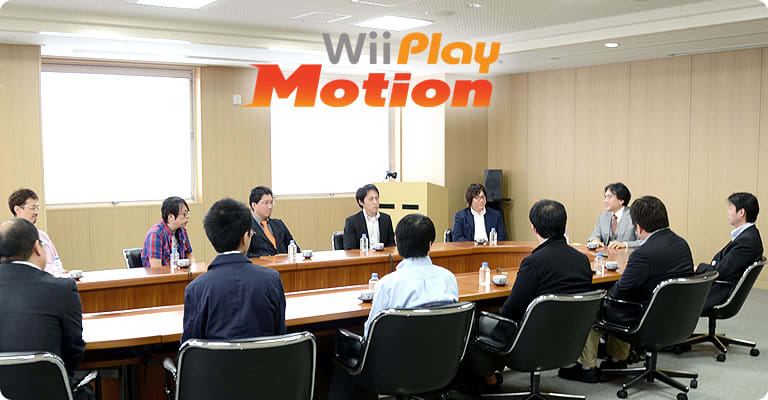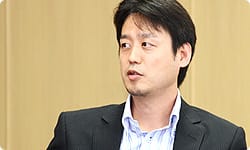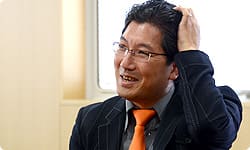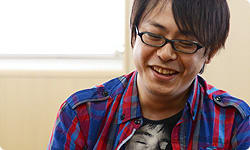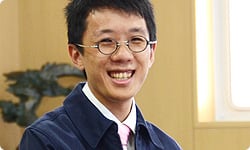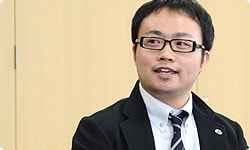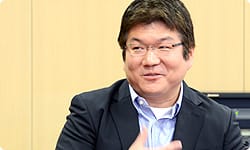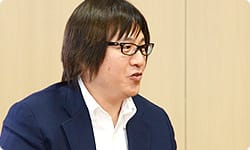"We'll Never Make It In!"
I think tempo is important for a collection of minigames like this. Did you have any trouble with the minigames' pacing?
When it came to tempo, we had trouble with Niitani-san's Teeter Targets.
Yeah. We had a hard time figuring out whether we should make it all continuous or make separate stages. In the end, we gave precedence to the view that players would want to play one stage over and over again, and separated them, but if we had merely wanted to give tempo precedence, we could have made all the stages continuous.
It isn't comfortable when the space between beats is off, so you can't play for a long time.
About February to March, when the games came together, places where the tempo wasn't great came into relief, like with the timing being poor in places and the tutorial being long.
And when it came to evaluating each game, we placed emphasis on tempo with regard to other game elements as well, like by making sure the medals appeared with similar timing, adjusting the connections between sequences, and making sure the tutorials weren't tedious.
Were you afraid it wouldn't come together?
Yes. I hate to say it, but when I looked at everyone's progress, it didn't look like they were moving very fast. Nonaka-san said we were in danger of getting dropped, so we tried as hard as we could to keep up. Then partway way through, we stopped looking at the other games and were like, "Let's be the only ones who survive!" (laughs)
Being able to see the other games could be helpful, but it could also throw you off.
Our approach this time was to make decisions as the minigames came together. We hadn't told each company the order that the minigames would be in or how many minigames there would be. There could have been from 12 to 14, with 8 also a possibility. Sorry to bring that up now! (laughs)
The whole time, we thought, "We'll never make it in!" According to Nintendo's schedule, we were almost done about the end of January, but when we took a look, the other companies didn't appear to be done at all. We were really worried, like, "What's going on here?"
Which games were you especially worried about in January?
Veggie Guardin' and Skip Skimmer. (laughs) To be honest, we thought they might not make it in. With regard to Veggie Guardin', we couldn't whack moles at all about the end of January. (laughs)
It had gotten off to a late start.
Then one day, I suddenly thought, "Oh, Trigger Twist just might make it in!" Actually, we had said to Nintendo that we wanted to do something that would permeate the whole game.
Then later on, Nonaka-san told us to make a model because he wanted UFOs to appear in all the minigames, so I was like, "Huh? He wants a model, so does that mean he hasn't dropped us?" (laughs)
Oh, so the UFO from Trigger Twist appears in all the minigames?
Yes. A UFO appears somewhere in each of the other games.
Taniguchi-san, were you also uneasy?
Yeah. The whole time! I had heard that Wind Runner was viewed favorably, but then I suddenly noticed that the number of minigames had fallen below what I had originally thought, and I began wondering if we were all right. (laughs)
Yeah. You'd think, "Huh?! That one game is gone!"
Because you couldn't get a view of the whole thing.
Right. We didn't know where each game stood. But it came together nicely in the end, so I'm glad.
How about you Eto-san?
I was most worried about whether it would come together. Lots of extremely distinctive minigames were being compiled, so I worried that simply slinging them all in the same package would result in something disjointed. But when I tried the master ROM, it felt unified as if a single company had made it all.
Did you worry, Niitani-san?
As someone who had to see the overall picture, I was full of unease right from the start! (laughs) When I heard about the development period, I wondered if we could finish in time, and when I heard how many companies were involved, I worried whether we could coordinate it all, and once we had gathered all those distinctive prototypes, I worried about how we could bring them all together into one package. Then around January, I began to wonder whether we would make the deadline. (laughs) I didn't calm down until about March.
Was this your first experience making a game?
Yes. It was my first time to go through the process of going from prototype to final form, so I just thought, "I'll trust in Nonaka-san and follow him!" (laughs)
And if I fall, you fall! (laughs)
Looking back now, what do you think pulled it all together in the end? Funaki-san?
The moment I thought it would work was when the icons on the menu screen went from their cube form to the spread you see now. That was when I realized for the first time that they had come together.
We changed that because of something you said, Iwata-san. You said, "Is the cube arrangement temporary?" We thought it was final, but…
When many people with different sensibilities gather together to work, there's a kind of chain reaction by which something someone says offhand or someone else showing their output resonates through various people and something else changes.
There was more pressure to make something good than if we had been working alone.
Because many eyes are looking at it. I feel like that's why it polished up so distinctively. Particularly toward the end, as you looked at each other's minigames and determined your own spot and brought it into shape, everything changed and snapped into place. How about you Mizobe-san?
I think something else that ties them all together is that the characters are Mii characters. For example, in Trigger Twist, your Mii character strikes a cool pose at the beginning, and in Spooky Search, your family and friends tell you where the ghosts are, so the atmosphere encourages everyone to play together.
Ah, I see. And you, Ebisu-san?
We made our own sound, but when Nintendo unified the sound, I felt like they really poured in effort. I could see how adjusting the way you play the sounds and their rhythm has an effect on the tempo of the whole game.
Takahashi-san, did you feel at the start like you had a strong chance of successfully pulling it all together?
Well, we tackled it because we thought so (laughs wryly), but looking at Wii Play, it isn't all that uniform.
Yes, the minigames are fairly varied. Wii Play came about when (Shigeru) Miyamoto-san said that it would be a waste to simply mothball the software we had made for testing early during development of the Wii console. We had never sold anything like that before, but Miyamoto-san saw the potential. That game came about because of his insight with regard to packaging multiple games together.
The game itself didn't feel unified, so I thought it would be fine to draw on each team's character to create something that shone.
You wanted each minigame to have something that shone.
Yes, and once that happened, I thought we could bind them all together by adjusting the sound, user interface and other elements. So that's why once this year started, the quality shot up. It actually came together faster than I expected. (laughs) I'm satisfied with the result.
